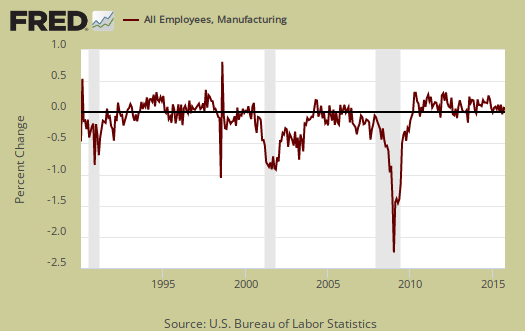The November ISM Manufacturing Survey is truly awful. It shows the manufacturing sector has just gone into contraction. This is after months of warning as growth stuttered. PMI was 48.6%. The composite PMI decreased by -1.5 percentage points and new orders plunged by -4.0 percentage points. The only real positive was the employment in manufacturing grew according to the survey. Overall the report really shows a a contracting U.S. manufacturing sector, the first in three years. Once again the canary in the economic coal mine is suffocating.

The ISM Manufacturing survey is a direct survey of manufacturers. Generally speaking, indexes above 50% indicate growth and below indicate contraction. Every month ISM publishes survey responders' comments, which are part of their survey. This month the petroleum industry says low prices are here to stay, negatively impacting their business and others mention the artificially strong U.S. dollar impacting their China export sales.
New orders really nose dove by -4.0 to 48.9%. This is in contraction.

The Census reported October durable goods new orders increased by 3.0%, where factory orders, or all of manufacturing data, will be out later this week. Note the Census one month behind the ISM survey. The ISM claims the Census and their survey are consistent with each other and they are right. Below is a graph of manufacturing new orders percent change from one year ago (blue, scale on right), against ISM's manufacturing new orders index (maroon, scale on left) to the last release data available for the Census manufacturing statistics. Here we do see a consistent pattern between the two and this is what the ISM says is the growth mark:
A New Orders Index above 52.3 percent, over time, is generally consistent with an increase in the Census Bureau's series on manufacturing orders.

Below is the ISM table data, reprinted, for a quick view.
| ISM Manufacturing November 2015 | ||||||
|---|---|---|---|---|---|---|
| Index | November 2015 | October 2015 | % Change | Direction | Rate of Change | Trend Months |
| PMI™ | 48.6 | 50.1 | -1.5 | Contracting | From Growing | 1 |
| New Orders | 48.9 | 52.9 | -4.0 | Contracting | From Growing | 1 |
| Production | 49.2 | 52.9 | -3.7 | Contracting | From Growing | 1 |
| Employment | 51.3 | 47.6 | +3.7 | Growing | From Contracting | 1 |
| Supplier Deliveries | 50.6 | 50.4 | +0.2 | Slowing | Faster | 4 |
| Inventories | 43.0 | 46.5 | -3.5 | Contracting | Faster | 5 |
| Customers' Inventories | 50.5 | 51.0 | -0.5 | Too High | Slower | 4 |
| Prices | 35.5 | 39.0 | -3.5 | Decreasing | Faster | 13 |
| Backlog of Orders | 43.0 | 42.5 | +0.5 | Contracting | Slower | 6 |
| Exports | 47.5 | 47.5 | 0.0 | Contracting | Same | 6 |
| Imports | 49.0 | 47.0 | +2.0 | Contracting | Slower | 2 |
| OVERALL ECONOMY | Growing | Slower | 78 | |||
| Manufacturing Sector | Contracting | From Growing | 1 | |||
Production is the current, we're makin' stuff now meter and plunged by -3.7 percentage points to 48.9%. This means production also just moved into contraction. Production usually follows incoming orders in the next month.

ISM's manufacturing production index loosely correlates to the Federal Reserve's industrial production, but not at 50% as the inflection point, instead 51.1% to indicate growth. Below is a quarterly graph of the ISM manufacturing production index (left, maroon), centered around the inflection point, quarterly average, against the Fed's manufacturing industrial production index's quarterly change (scale right, blue). We can see there is a matching pattern to the two different reports on manufacturing production.

The manufacturing ISM employment index surprisingly shot up by 3.7 percentage points to 51.3%. . The neutral point for hiring vs. firing is 50.6%, but at this point we'll take any growth. Below are the BLS manufacturing non-farm payrolls (jobs) for the past decade on the left (maroon), graphed against the ISM manufacturing employment index on the right (blue). The BLS manufacturing payrolls is the monthly percentage change and the ISM manufacturing employment index is centered around it's inflection point of contraction and employment growth.

The inventories index has been contracting for the 5th month in a row with and now faster in acceleration. This is actually a horrific indicator. Changes in inventories contributes to GDP. Inventories gives an estimate of how much raw materials manufacturers have on hand and the contraction implies manufacturers expect a slow down to continue. Quoted below is the relationship between BEA and ISM inventories, not the 50% inflection point one would assume.
An Inventories Index greater than 42.9 percent, over time, is generally consistent with expansion in the Bureau of Economic Analysis' (BEA) figures on overall manufacturing inventories in chained 2000 dollars.

Supplier deliveries are how fast manufacturers can get their supplies. A value higher than 50 indicates slower delivery times, a value below 50 means the supply chain is speeding up. The index increased by 0.2 percentage points to 50.6% which is slightly positive. You may wonder why slow deliveries would boost up PMI and indicate stronger growth in manufacturing. The reason is slower vendor performance means there is probably higher demand for that supply and thus indicates increasing activity.

Order backlogs increased by 0.5 percentage points to 43.0%. Order backlogs have been in contraction for the last six months. Less order backlogs would imply there is no need to ramp up production to catch up.

Imports increased by 2.0 percentage points to 49.0%. Imports are in contraction although less so than last month. Imports are materials from other countries manufacturers use to make their products and high levels isn't too great for economies of scale in the U.S. We want to see U.S. manufacturers use other U.S. manufactured materials instead of imports as much as possible.

New orders destined for export, or for customers outside of the United States continue to decline with a 47.5% index value and had no change in that rate of decline from last month. Exports can imply a decline in global demand.

Prices decreased by -3.5 percentage points to 35.5%, which is decreasing and faster. Declining prices has been going on for 13 months now. The ISM gives an index correlation to BEA price increases of 52.1%.

Customer's inventories decreased by -1.5 percentage points to 50.5%. Customer inventories, not to be confused with manufacturer's inventories, are how much customers have on hand, and rates the level of inventories the organization's customers have.

Here is the ISM industrial sector ordered list of growth and contraction. What is most disturbing is how many sectors are now shrinking.
Of the 18 manufacturing industries, five are reporting growth in November in the following order: Printing & Related Support Activities; Nonmetallic Mineral Products; Miscellaneous Manufacturing; Food, Beverage & Tobacco Products; and Transportation Equipment. The 10 industries reporting contraction in November — listed in order — are: Apparel, Leather & Allied Products; Plastics & Rubber Products; Machinery; Primary Metals; Petroleum & Coal Products; Electrical Equipment, Appliances & Components; Computer & Electronic Products; Furniture & Related Products; Fabricated Metal Products; and Chemical Products.
The ISM has a correlation formula to annualized real GDP. November alone gives a 1.7% annual real GDP correlation, yet for the year, indicates a 2.7% increase. The below graph plots real GDP, left scale, against PMI, right scale, real GDP up to Q3 2015. One needs to look at the pattern of the two lines to get anything out of this by quarters graph. If they match, GDP goes up, PMI goes up, would imply some correlation. Yet the estimate against itself is telling, November's 1.7% is a very low correlation estimate from the ISM.

The ISM manufacturing index is important due to the economic multiplier effect. People should really take note of this report and for anyone who cares about working America, this report can make one cry. While manufacturing is about an eighth of the economy, it is of scale and spawns all sorts of additional economic growth surrounding the sector.
PMI is a composite of equally weighted and seasonally adjusted New Orders, Production, Employment, Supplier Deliveries and Inventories.
The ISM neutral point is 50, generally. Above is growth, below is contraction, There is some some variance in the individual indexes and their actual inflection points as noted above. Here are past manufacturing ISM overviews, unrevised. The ISM has much more data, tables, graphs and analysis on their website. PMI™ stands for purchasing manager's index. On ISM correlations to other indexes, when in dollars they normalized to 2000 values. The above graphs do not do that, so our graphs are much more rough than what the ISM reports these indices track.
Note: The ISM is seasonally adjusting some of these indexes and not others due to the criteria for seasonal adjustment. Those indexes not seasonally adjusted are: Inventories, Customers' Inventories, Prices, Backlog of Orders, New Export Orders and Imports.

6,000 Manufacturing Jobs
ADP reports companies had added 217,000 jobs in November. Service sector firms added 204,000, while manufacturers hired just 6,000.
http://www.adpemploymentreport.com/2015/November/NER/NER-November-2015.aspx
* Was this uptick in service jobs (as usual) because of temp hiring for the holidays?